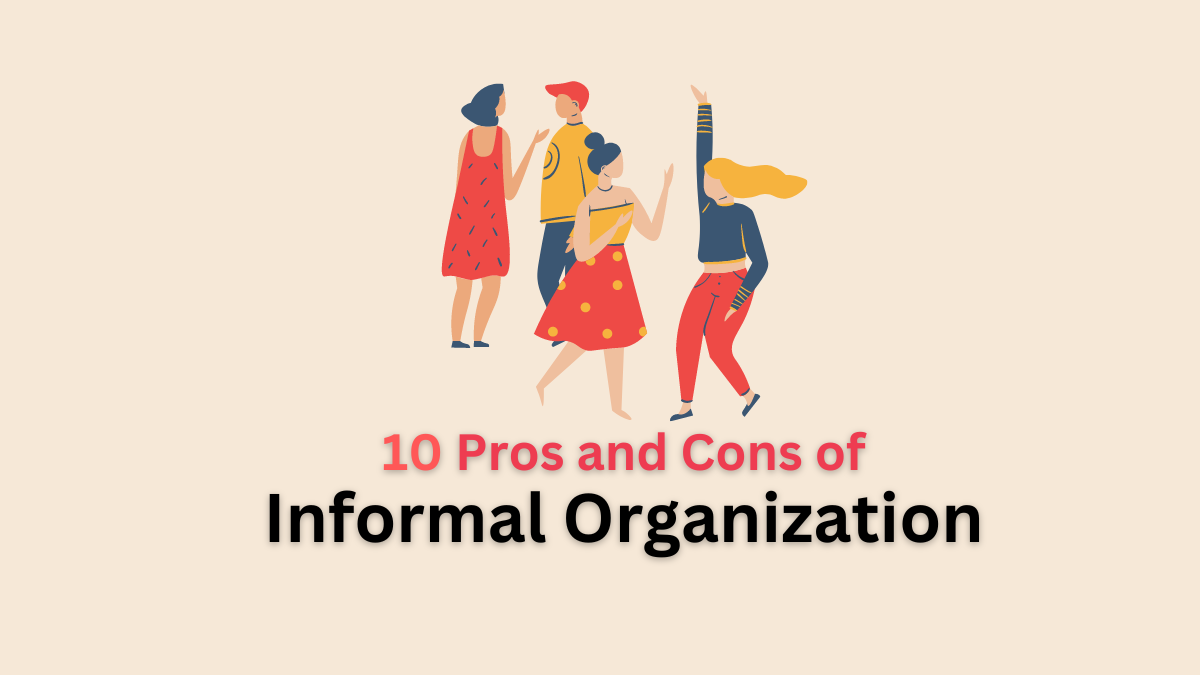Pros and Cons of Informal Organization
An informal organization refers to the network of interpersonal relationships, norms, and shared interests that develop spontaneously among employees within a formal organizational structure. Unlike formal organizations that are intentionally designed and structured by management, informal organizations emerge naturally through social interactions, shared experiences, and common goals among employees.
Here, we will discuss about 10 major pros and cons of informal organization in business setting, so let’s get started:
Pros of Informal Organization
Let’s explore the five key benefits of informal organizations:
Enhanced Communication and Information Flow
Informal organizations facilitate rapid communication among employees. Information travels quickly through informal networks, often reaching individuals faster than formal channels allow.
This agility in communication enables quicker decision-making, problem-solving, and adaptation to changes in the business environment. Unlike formal structures that may impose hierarchical barriers, informal networks promote open dialogue and idea-sharing, fostering innovation and efficiency.
Increased Job Satisfaction and Morale
By fulfilling social needs such as camaraderie, recognition, and emotional support, informal organizations contribute significantly to employee job satisfaction. Employees who feel connected to their peers through informal groups are often more motivated and engaged in their work.
This sense of belonging enhances morale, reduces turnover rates, and promotes a positive organizational culture where individuals feel valued beyond their formal roles.
Flexibility and Adaptability
Informal structures are inherently flexible and adaptable. They can respond quickly to changes in the business environment or operational needs because they operate based on interpersonal relationships rather than rigid hierarchical protocols.
In times of crisis or uncertainty, informal networks can innovate and problem-solve more effectively, leveraging diverse perspectives and creative solutions that might not emerge within formal structures constrained by rules and procedures.
Support for Organizational Goals
While informal organizations may not have formal roles or responsibilities, they often align their activities with organizational goals. Informal groups can act as complementary forces that support and reinforce formal initiatives.
By fostering a shared understanding of company objectives and facilitating collaboration across departments or levels, informal networks contribute to overall organizational effectiveness and goal achievement.
Read More: 10 Pros and Cons of Time Departmentalization
Employee Integration and Socialization
New employees benefit from informal organizations by quickly integrating into the workplace culture. Informal groups provide a platform for newcomers to establish relationships, learn informal norms, and gain insights into organizational dynamics that formal orientations may not fully convey.
This socialization process helps new hires feel welcome and supported, enhancing their job satisfaction and reducing the time needed to become productive contributors.
Cons of Informal Organization in Business
Informal organizations also pose some challenges, here are five to mention:
Resistance to Organizational Change
Informal organizations can resist changes introduced by formal management, especially if these changes disrupt established norms or threaten group dynamics.
Resistance to change can hinder organizational agility and delay the implementation of strategic initiatives aimed at improving efficiency or competitiveness. Overcoming resistance requires effective communication, leadership, and alignment of informal networks with organizational goals.
Read More: 10 Pros and Cons of Delegation of Authority
Potential for Conflict and Cliques
Interpersonal conflicts or cliques within informal groups can create divisions and undermine workplace harmony. Miscommunication, favoritism, or exclusionary behaviors within informal networks can lead to tension, reduced collaboration, and decreased productivity.
Managers must actively monitor and manage group dynamics to mitigate conflicts and ensure that informal structures contribute positively to the overall organizational culture.
Informal Communication Challenges
While informal networks excel in rapid information dissemination, they can also propagate rumors, misinformation, or gossip. Inaccurate information circulating through informal channels can lead to misunderstandings, distrust, and decreased morale among employees.
Maintaining clarity and transparency in communication, both formal and informal, is essential to minimize the negative impact of rumors and ensure alignment with organizational objectives.
Read More: 10 Pros and Cons of Centralization of Authority
Lack of Accountability and Formal Oversight
Unlike formal structures with clearly defined roles and responsibilities, informal organizations may lack accountability mechanisms. Decisions made within informal groups may not be transparent or aligned with organizational policies, potentially leading to inconsistent outcomes or conflicts with formal directives.
Managers face challenges in balancing the autonomy and creativity of informal networks with the need for accountability and adherence to organizational standards.
Distraction from Formal Responsibilities
Employees heavily engaged in informal groups may prioritize social interactions over their formal job responsibilities. While informal networks enhance job satisfaction and morale, excessive involvement can detract from productivity and task completion.
Balancing the benefits of informal relationships with the need for individual and team performance requires clear expectations, performance management, and supportive leadership.
In conclusion, while informal organizations offer valuable benefits such as enhanced communication, job satisfaction, and flexibility, they also present challenges related to change management, conflicts, and accountability.
Read Next: 10 Pros and Cons of Planning in Management
